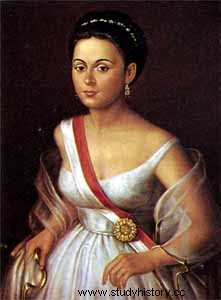Manuela Sáenz Aizpuru or Manuelita Sáenz (1797 – 1856) was an Ecuadorian patriot and revolutionary, a heroine of the struggle for independence from the former Spanish colonies and a figure of feminism in Latin America.
A convent education
 "Illegitimate" daughter of María Joaquina de Aizpuru and Spanish nobleman Simón Sáenz Vergara, Manuela Sáenz was born on December 27 1797 (or 1795) in Quito (Ecuador). Her mother having died the day she was born, or two years later, Manuela was entrusted to the convent of the Monjas Conceptas (Royal Monastery of the Pure and Immaculate Conception) where she was brought up by the superior, Sister Bonaventure.
"Illegitimate" daughter of María Joaquina de Aizpuru and Spanish nobleman Simón Sáenz Vergara, Manuela Sáenz was born on December 27 1797 (or 1795) in Quito (Ecuador). Her mother having died the day she was born, or two years later, Manuela was entrusted to the convent of the Monjas Conceptas (Royal Monastery of the Pure and Immaculate Conception) where she was brought up by the superior, Sister Bonaventure.
During her childhood, Manuela also spent time at her father's house, where she developed affectionate bonds with her stepmother and with her half-brother José María Sáenz. Once she completed her training with the Monjas Conceptas, Manuela was admitted to the Dominicans of Sainte-Catherine-de-Sienne, to receive the education of young girls from good families:she learned sewing, cooking, English. , French, the art of conversation. At seventeen, she ran away from the monastery.
Simón Bolivar
In December 1816, Manuela Sáenz's father arranged for her to marry the English physician James Thorne, who was 26 years older than her. They married in July 1817, in Lima (Peru). The young woman then began to take an interest in politics, getting involved in the fight to free Peru from Spanish rule in a context of tensions with the settlers, while her half-brother joined the army of release. She frequents officers and revolutionaries who keep her secret about the progress of the revolution. In July 1821, when José de San Martín seized Lima and proclaimed the independence of Peru, he awarded Manuela the title of Knight of the Order of the Sun of Peru (the highest civil and military distinction in Peru).
In 1821, upon the death of a maternal aunt, Manuela left her husband in Peru to return to Ecuador to claim his inheritance from his maternal grandfather. It was in Quito, on June 16, 1822, that she saw the Libertador for the first time. Simón Bolívar, who makes a triumphal entry into the city. They meet shortly after at a ball given for the Libertador , and fall in love, beginning an affair that will last until the death of Simón Bolívar.
The Liberator of the Liberator
Manuela Sáenz accompanies her lover in several of his campaigns, in which she participates actively, earning the rank of colonel in the army of independence. When not participating in military campaigns, she supported the revolution by gathering and disseminating information, and campaigning for women's rights. While her husband James Thorne asks her to come back to him, Manuela categorically refuses and declares that she wants to leave him and stay with Simón. This attitude, her outspokenness, her independence, her influence in politics, caused a scandal at the time and made her a vanguard in the fight for the emancipation of women.
In September 1828, in Santa Fe de Bogotá, Simón was the victim of an assassination attempt. He owes his life to the intervention of Manuela who, understanding what is happening, intervenes in front of the rebels and buys her lover time to escape. From then on, Simón nicknamed her Liberator of the Liberator . In May 1830, he died of tuberculosis and his death deeply affected Manuela. Subsequently, banished from Colombia, Manuela settled in Jamaica, Ecuador, then Peru. She lives from trade, embroidery or cooking, and translations. In 1847, James Thorne was assassinated but she could not recover any inheritance.
Manuela Sáenz died on November 23, 1856 at the age of 59, during an epidemic of diphtheria.
